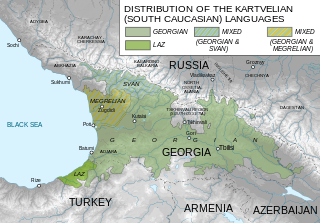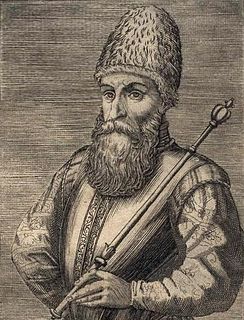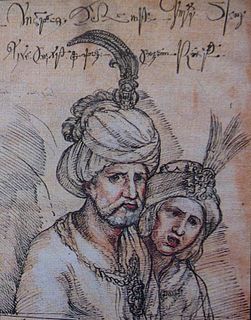Nestan-Darejan (Georgian :ნესტან-დარეჯანი) is a Georgian feminine given name, derived from the Persian nest andare jahan, roughly translated as "the matchless". It occurs in the epic poem by the 12th-century Georgian poet Shota Rustaveli. Afterwards, the name and its derivatives, Nestan (ნესტანი) and Darejan (დარეჯანი), were frequent in the Georgian royalty. [1]

Georgian is a Kartvelian language spoken by Georgians. It is the official language of Georgia. Georgian is written in its own writing system, the Georgian script. Georgian is the literary language for all regional subgroups of Georgians, including those who speak other Kartvelian languages: Svans, Mingrelians and the Laz.

Persian, also known by its endonym Farsi, is one of the Western Iranian languages within the Indo-Iranian branch of the Indo-European language family. It is a pluricentric language primarily spoken in Iran, Afghanistan and Tajikistan, Uzbekistan and some other regions which historically were Persianate societies and considered part of Greater Iran. It is written right to left in the Persian alphabet, a modified variant of the Arabic script.

Shota Rustaveli, mononymously known simply as Rustaveli, was a medieval Georgian poet. He is considered to be the preeminent poet of the Georgian Golden Age and one of the greatest contributors to Georgian literature. Rustaveli is the author of The Knight in the Panther's Skin, which is considered to be a Georgian national epic poem.
Notable people named Nestan-Darejan, Nestan, or Darejan were:
- Nestan-Darejan of Kakheti, Queen of Kartli (fl. 1556–1612), Princess of Kakheti and Queen Consort of Kartli
- Darejan of Kakheti, Queen of Imereti (c. 1615 – 1668), Princess of Kakheti and Queen Consort of Imereti
- Princess Darejan of Imereti (c. 1670 – 6 October 1740), Princess of Imereti
- Darejan Dadiani (20 July 1738 – 8 November 1807), Princess of Mingrelia and Queen Consort of Georgia
Nestan-Darejan was queen consort of Kartli, a kingdom in eastern Georgia, as the wife of King Simon I, whom she married in 1559. Nestan-Darejan was a daughter of King Levan of Kakheti and a half-sister of Levan's successor to the throne of Kingdom of Kakheti, Alexander II. Her husband spent nearly five decades fighting the Safavid Iranian and Ottoman encroachments on his kingdom, twice losing his throne and personal freedom. Nestan-Darejan suffered further, being humiliated by his half-brother, the king of Kakheti, who capitalized on Simon's difficulties to attack and loot Kartli. After Simon had been sent a prisoner to Iran in 1569, Nestan-Darejan's estates had been pillaged by Prince Bardzim Amilakhori, Alexander's father-in-law; and in 1580, following Simon's return to Kartli and his defeat by Alexander at Dighomi, the latter carried off after the battle his half-sister's drawers on the point of a lance. Nestan-Darejan outlived her husband and died sometime after 1612, having mothered six children, including Simon's successor to the throne of Kartli, George X.

Darejan or Nestan-Darejan (ნესტან-დარეჯანი) was a daughter of King Teimuraz I, a ruler of Kakheti in eastern Georgia, with a notable role in the contemporary politics of Georgia. Her three marriages represented a component of her family's and her own political machinations. Her first husband, Zurab, Duke of Aragvi, was put to death at the behest of Darejan's father in 1630. Her second and third marriages, to Alexander III and Vakhtang I, respectively in 1630 and 1661, made her a queen consort of Imereti, in western Georgia, where Darejan became embroiled in a series coups and counter-coups. She was eventually murdered by members of the rival party in Kutaisi.
Darejan or Darya was a daughter of Archil, sometime king of king of Imereti and of Kakheti in western and eastern parts of Georgia, respectively, by his wife Ketevan of Kakheti. In the 1680s, Darejan followed her parents and brothers into exile in Russia, where she lived a semi-secluded life, mostly at her family estate of Vsekhsvyatskoye at Moscow, occupied in local charity and benevolence.








